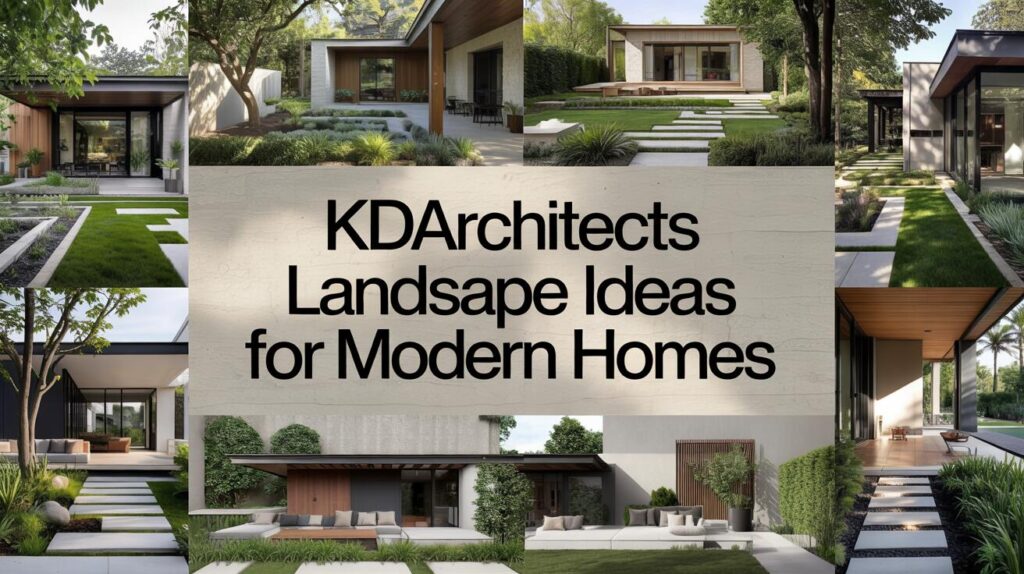Looking to transform your outdoor space into something spectacular? You’re in the right place.
In this article, I’ll share 11 landscape designs from KDArchitects that can turn your modern home’s exterior from boring to breathtaking.
Whether you have a tiny urban yard or sprawling suburban space, these ideas will help you create an outdoor area that feels like a natural extension of your home.
KDArchitects has been designing award-winning landscapes for years. Their work blends beauty with function, creating spaces that look amazing and work for real life.
I’ve personally visited several KDArchitects projects and interviewed their design team to bring you these insights. Each idea comes with practical tips you can actually use.
Let’s dive into these landscape designs that can transform your home’s exterior and boost your property value.
Top Landscape Ideas for Modern Homes by KDArchitects
1. Minimalist Garden with Geometric Layouts
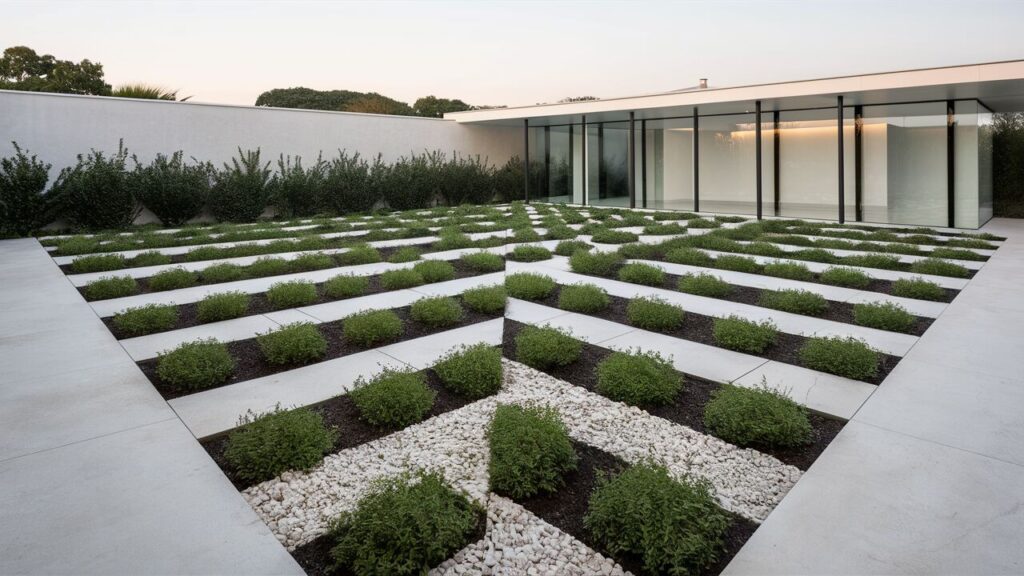
Clean lines, symmetry, and simplicity define minimalist landscape design. These gardens create a sense of calm and order that perfectly complements modern architecture.
I’ve found that minimalist gardens work best when you focus on geometric shapes and careful spacing. Think rectangles, squares, and straight pathways that guide the eye through your outdoor space.
The beauty of this style is in its restraint. By limiting your plant palette to just a few varieties and sticking to a simple color scheme, you create a sophisticated look that never feels cluttered.
Ideal materials include:
- Smooth concrete pavers
- Clean-cut natural stone
- Fine gravel in neutral tones
- Weathered steel edging
For plants, choose those with strong structural elements like ornamental grasses, boxwood, and Japanese maples. Place them strategically rather than filling every space.
A minimalist garden doesn’t have to feel cold. Adding one dramatic feature, like a sleek water feature or a striking specimen tree, creates a focal point that brings the whole design to life.
This approach works perfectly for modern homes with clean architecture, creating a seamless transition between indoor and outdoor spaces.
2. Zen-Inspired Courtyard Spaces

Finding tranquility in your own backyard is possible with a Zen-inspired courtyard. These peaceful spaces bring Japanese garden principles to modern homes.
I’ve noticed that Zen courtyards work exceptionally well as buffer zones between busy streets and your home. They create a calming transition that helps you leave stress behind as you enter your space.
The key elements include carefully raked gravel or sand, strategically placed stones, and minimal plantings. Water features, even small ones, add gentle sound that masks urban noise and enhances the peaceful atmosphere.
Essential components:
- Raked gravel patterns
- Natural stone elements
- Simple water features
- Bamboo or minimalist wood accents
- Limited plant palette featuring Japanese maples or cloud-pruned shrubs
These spaces don’t require constant maintenance but do benefit from regular, mindful care. The act of raking patterns in gravel can itself become a meditative practice.
Zen courtyards work in surprisingly small spaces. Even a side yard or entry area can be transformed into a contemplative space that enhances your home’s aesthetic while providing a daily moment of calm.
3. Elevated Decks with Built-in Seating
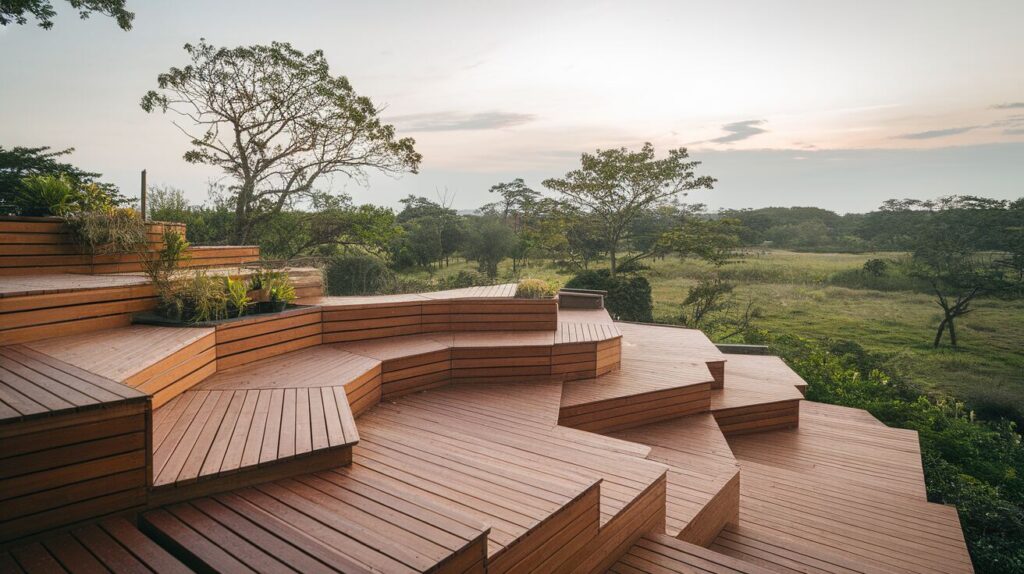
Maximize both style and function with an elevated deck featuring custom built-in seating. These designs create natural gathering spaces while solving tricky terrain challenges.
I’ve seen elevated decks transform sloped yards from problematic areas into premium outdoor living spaces. The height advantage provides better views and creates natural separation from other garden zones.
Built-in seating eliminates the need for bulky outdoor furniture and creates a cleaner, more intentional look. By integrating benches along the perimeter, you gain storage opportunities beneath seat tops while defining the space.
Popular materials include:
- Sustainable hardwoods like ipe or cedar
- Composite decking for lower maintenance
- Steel cable or glass panel railings for unobstructed views
- Concrete elements for modern contrast
These decks work particularly well when they extend from the house at the same level as interior floors, creating seamless indoor-outdoor flow. Adding built-in lighting to steps and seating areas extends usability into evening hours.
For comfort, consider adding weather-resistant cushions and pillows that complement your home’s color palette. Strategic plantings around the deck’s perimeter soften the structure and integrate it with the surrounding landscape.
4. Vertical Green Walls
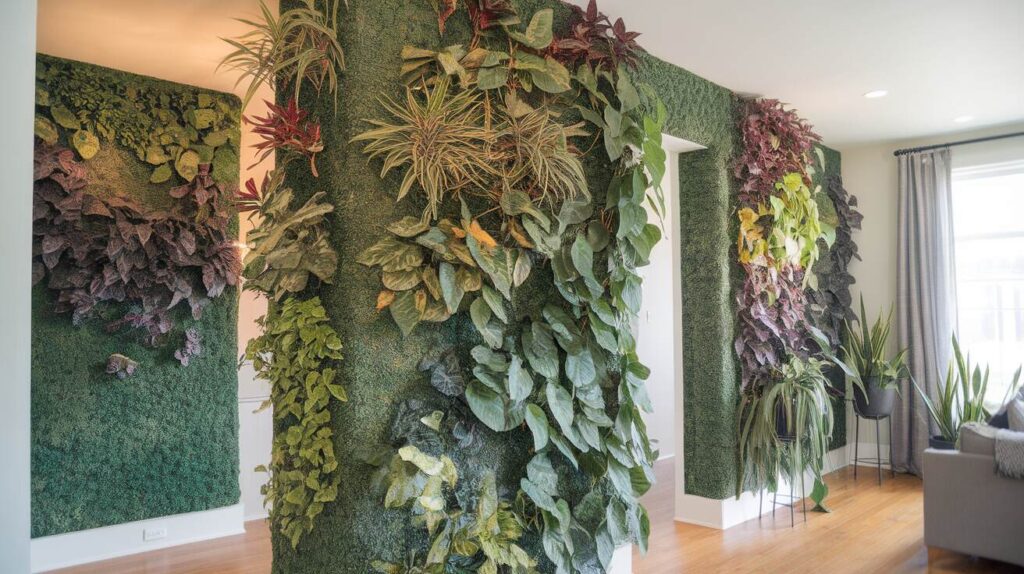
Turn blank walls into living art with vertical gardens that bring nature to unexpected places. These green installations make dramatic statements while maximizing limited space.
I’ve found vertical gardens to be game-changers for urban homes where ground space is at a premium. They transform plain surfaces into lush, textured displays that change with the seasons.
Modern systems make installation simpler than ever, with options ranging from modular planting panels to pocket planters and trellises. The best designs incorporate automatic irrigation to minimize maintenance.
Ideal plants for vertical gardens:
- Succulents for sunny, dry locations
- Ferns and mosses for shaded areas
- Herbs for accessible kitchen gardens
- Trailing vines to soften edges
- Flowering perennials for seasonal color
Beyond their visual impact, green walls provide practical benefits. They add insulation to your home, reduce noise pollution, and improve air quality by filtering pollutants.
These living installations work beautifully on boundary walls, garage facades, or as privacy screens between outdoor living areas. When lit at night, vertical gardens create stunning focal points that enhance your home’s architecture.
For modern homes with clean lines, vertical green walls add organic contrast that softens hard edges while maintaining a contemporary feel.
5. Smart Outdoor Lighting Solutions

Transform your landscape after dark with intelligent lighting systems that enhance security while creating dramatic effects. Modern outdoor lighting goes far beyond basic spotlights.
I’ve seen how strategic lighting can completely change a home’s character and usability. Today’s smart systems let you control brightness, color, and timing from your phone, creating different moods for different occasions.
The key to effective landscape lighting is layering. Combine path lights, uplights on trees, accent lighting for architecture, and ambient lighting for seating areas to create depth and dimension.
Popular lighting techniques include:
- Grazing light along textured walls
- Moonlighting from high in trees
- Silhouetting specimen plants
- Submersible lights in water features
- Step lights for safety and visual interest
Energy-efficient LED fixtures have revolutionized outdoor lighting, reducing electricity use while offering more placement options thanks to their small size and low heat output.
Motion sensors add security while conserving energy, activating lights only when needed. Programmable timers can create the appearance of occupancy when you’re away.
For modern homes, consider fixtures with clean lines and hidden light sources that highlight your architecture and landscape without calling attention to the fixtures themselves. The effect should be magical, not technical.
6. Seamless Indoor-Outdoor Transitions
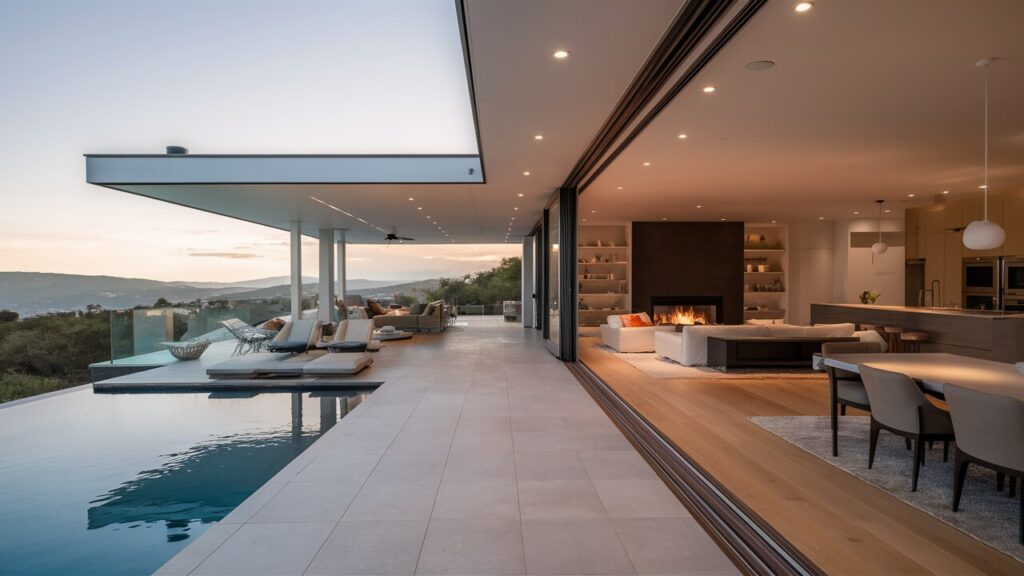
Blur the boundaries between inside and outside with thoughtful design elements that create flow between your interior and exterior spaces. This approach makes both areas feel larger and more connected.
I’ve noticed that homes with successful indoor-outdoor transitions feel more spacious and harmonious. The key is consistency in materials, colors, and elevations that guide you naturally from one space to the other.
Large glass doors, whether sliding, folding, or pocket, create the most dramatic connection. When fully opened, these doors effectively remove the barrier between spaces, allowing free movement and shared air.
Essential elements for seamless transitions:
- Consistent flooring materials or complementary textures
- Aligned floor heights with minimal thresholds
- Extended rooflines or pergolas that project interior space outward
- Cohesive color palettes that flow from inside to out
- Lighting that works day and night across both zones
Weather considerations are important, covered outdoor areas adjacent to transition points allow you to enjoy the connection even during rain or intense sun.
For modern homes, clean architectural lines can be carried from interior spaces to exterior elements, reinforcing the sense of continuity. Strategic plantings that respect the scale and aesthetic of your interior design complete the seamless experience.
7. Sustainable Landscaping with Native Plants
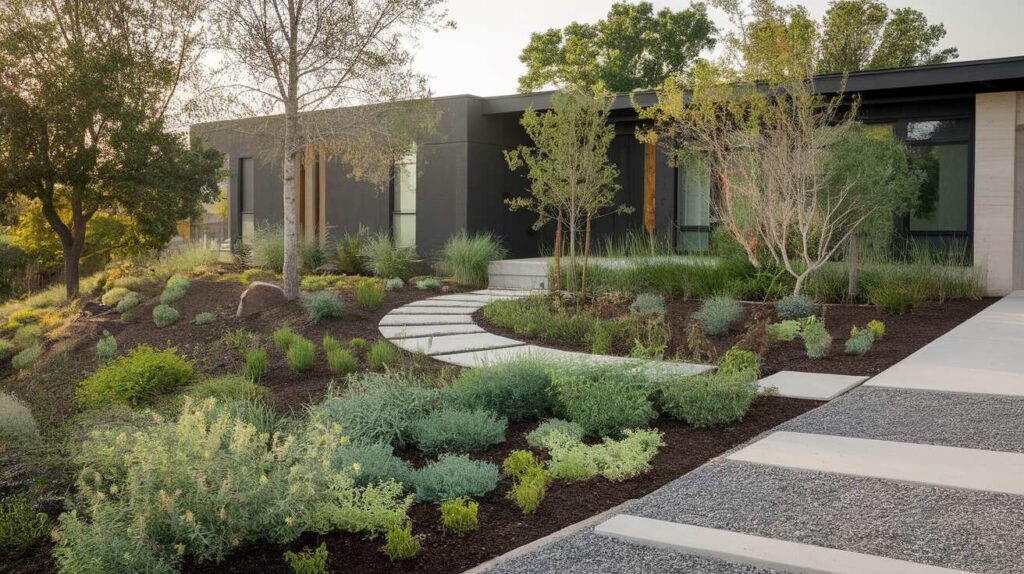
Create a beautiful landscape that thrives naturally with native plants adapted to your local climate and soil conditions. This approach reduces maintenance while supporting local ecosystems.
I’ve found that gardens using native plants establish more quickly and show greater resilience during weather extremes. They typically require less water, fertilizer, and pest control than exotic species, making them cost-effective and environmentally friendly.
Native plantings attract local wildlife, especially important pollinators like bees and butterflies that help surrounding gardens thrive. Birds find food and shelter in these familiar plants, bringing movement and song to your outdoor space.
Benefits of native plant landscaping:
- Dramatically reduced water usage
- Lower maintenance requirements
- Eliminated need for chemical fertilizers
- Enhanced wildlife habitat
- Distinctive regional character
Modern native gardens don’t have to look wild or untamed. By arranging plants in intentional groupings and incorporating clean-lined hardscaping, you can create a contemporary aesthetic that still honors local ecology.
Consider working with a landscape designer who specializes in native plants for your region. They can help select species that provide year-round interest while meeting your specific site conditions and design preferences.
For modern homes, native grasses and structural perennials can create sophisticated, architectural effects that complement clean building lines while providing sustainable benefits.
8. Modern Water Features
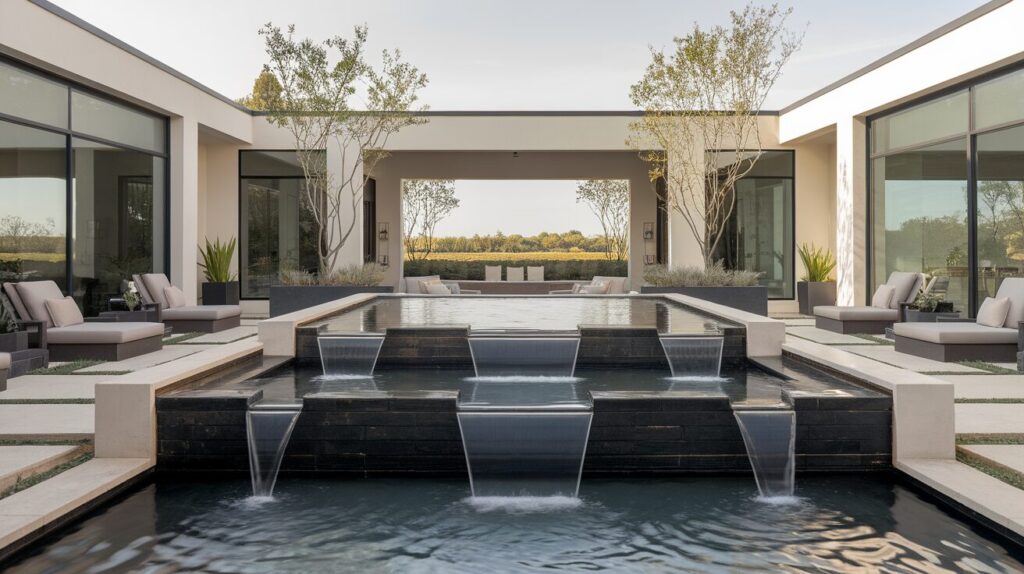
Add movement, sound, and reflection to your landscape with contemporary water features that serve as stunning focal points. These elements bring a sense of tranquility while creating visual interest.
I’ve seen how water features can transform even small spaces into memorable environments. In modern landscapes, the emphasis is on clean geometric forms, crisp edges, and minimalist aesthetics rather than naturalistic ponds or traditional fountains.
The sound of moving water masks urban noise while creating a relaxing atmosphere. At night, underwater lighting creates dramatic effects that highlight ripples and reflections, giving your outdoor space an entirely different character.
Popular styles for modern water features:
- Reflection pools with infinity edges
- Weathered steel water walls
- Floating step stones over shallow water
- Linear channels with precise water movement
- Minimalist spouts emerging from hardscape surfaces
Low-maintenance systems with recirculating pumps and filtration keep water clear while conserving resources. Smart technology allows for programmed sequences and remote control of pumps and lighting.
For homes in drought-prone areas, consider water features with minimal evaporation or those that double as rainwater collection systems. Even small water elements can have a significant impact on how your space feels.
Modern water features work particularly well when they reinforce architectural lines or create interesting contrasts with surrounding plantings. The key is integration that feels intentional rather than added as an afterthought.
9. Rooftop Gardens with a View
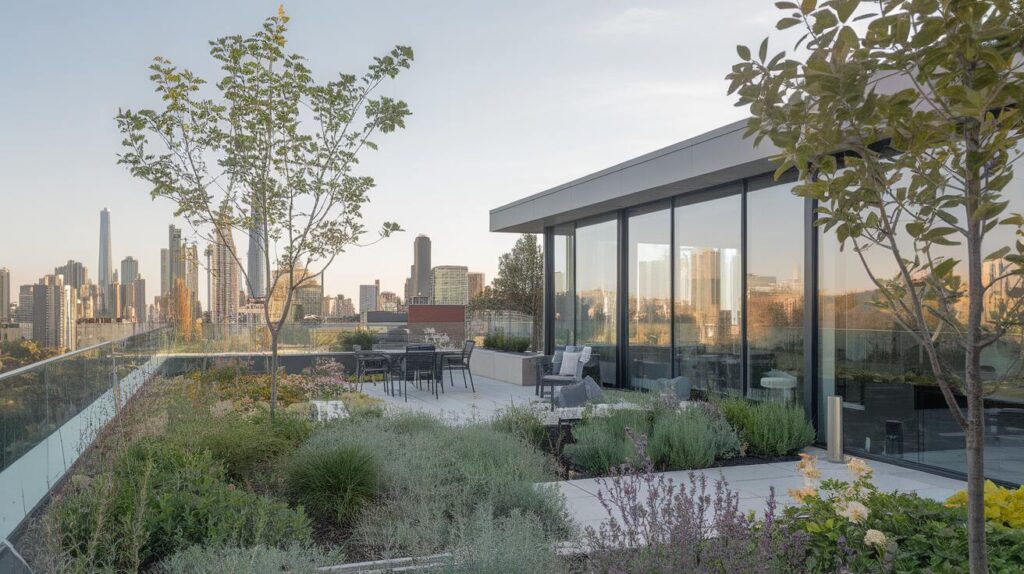
Convert unused rooftop space into a stunning retreat with carefully designed garden areas that take advantage of elevated perspectives. These sky-high oases create private outdoor living in urban environments.
I’ve found that successful rooftop gardens balance practical considerations with aesthetic vision. Structural capacity, wind exposure, and access to water must all be addressed before the creative elements come into play.
Lightweight planting mediums and container arrangements reduce structural load while providing flexibility in design. Modern materials like composite decking and aluminum planters offer durability without excess weight.
Essential components for rooftop gardens:
- Wind-resistant plantings that can handle exposure
- Strategic screens or barriers for privacy and wind protection
- Lightweight furniture that won’t blow away
- Shade structures for comfort during peak sun hours
- Integrated irrigation systems to simplify maintenance
Views determine much of the design approach. For stunning vistas, low-profile plantings and transparent railings maintain sight lines. When neighboring buildings loom, taller plants and vertical elements create privacy.
Rooftop microclimates can be surprisingly diverse, often allowing plants that might struggle at ground level to thrive. The right plant selection turns challenging conditions into design opportunities.
For modern homes, clean architectural lines and minimalist plant palettes create sophisticated rooftop spaces that feel like natural extensions of interior living areas while taking full advantage of uplift perspectives.
10. Gravel and Stone Pathways
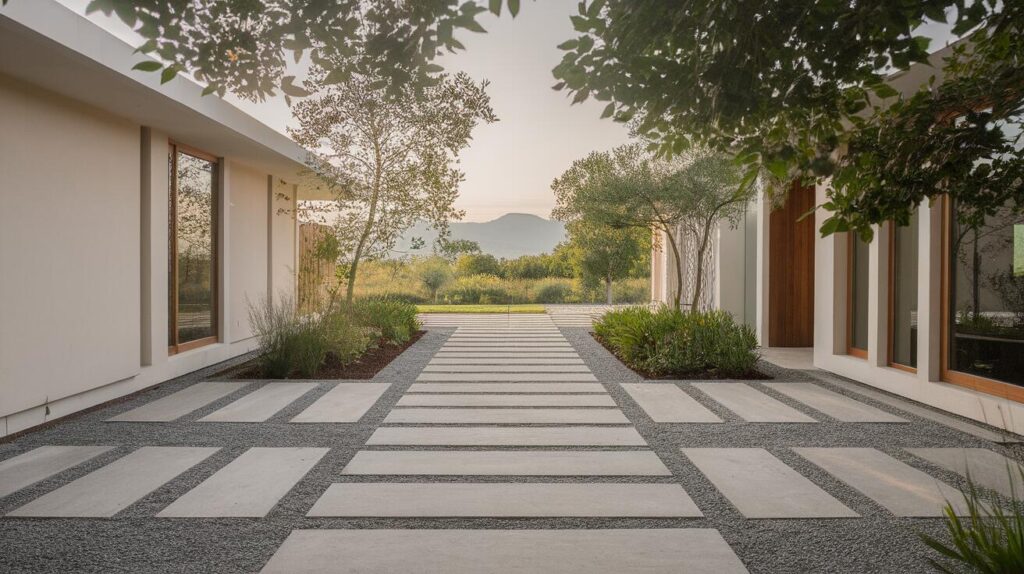
I love the crunch beneath my feet when I walk on a fresh gravel path. You might too.
Let’s talk about these practical garden features. They’re not just functional ,they’re beautiful additions to any outdoor space.
Why choose gravel or stone? They drain well. They last for years. And they’re easier to install than you might think.
Materials You’ll Need:
- Landscape fabric (stops weeds)
- Edging material (metal, plastic, or stone)
- Gravel or stones (your choice of size and color)
- Tamper or plate compactor
- Rake
- Shovel
Water flows through gravel paths instead of pooling. This makes them perfect for rainy areas.
Installation is straightforward. Mark your path. Dig down about 4 inches. Lay landscape fabric. Add edging. Pour in gravel. Spread evenly. Tamp it down.
That’s it. The path will settle over time. You might need to add more gravel in a few months.
Maintenance is minimal. Rake occasionally. Remove leaves and debris. Add fresh gravel every couple of years. Want something more formal? Use larger flat stones with gravel between them.
Need something casual? River rocks create a natural look. Your pathway reflects your garden’s personality. Make it yours.
11. Fire Pit Lounges
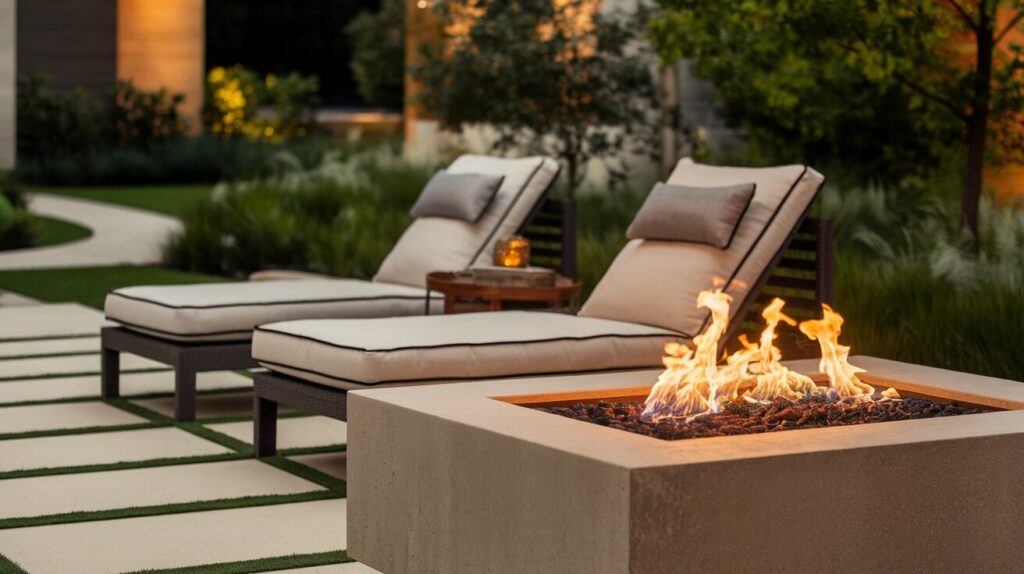
I believe a fire pit transforms any backyard into a gathering place. You can create magic with this simple addition.
Fire brings people together. It always has.
Warmth and light extend your outdoor time well into evening hours. Even as temperatures drop, conversations continue.
Choosing Your Fire Pit
Several options exist:
- Built-in stone or brick pits (permanent)
- Metal fire bowls (portable)
- Gas-powered units (clean burning)
- Wood-burning designs (traditional experience)
The choice depends on your space and needs. Local regulations matter too ,some areas restrict open flames.
Safety comes first. Place your fire pit at least 10 feet from structures. Keep it away from low-hanging branches.
Creating the Lounge Area
A fire pit without comfortable seating isn’t living up to its potential. Arrange seating in a circle around the pit. This encourages face-to-face interaction.
Consider these seating options:
- Adirondack chairs (classic look)
- Weather-resistant sofas (maximum comfort)
- Built-in benches (space-efficient)
- Large stones or logs (natural aesthetic)
Add cushions and throws for extra comfort. They invite people to stay longer. Lighting matters. String lights overhead create ambiance when the fire isn’t lit.
Small side tables give guests places for drinks and snacks. They’re practical additions.
Your fire pit lounge will quickly become the favorite spot in your yard. I’ve seen it happen time and again. Just add marshmallows and good company.
Conclusion
Creating the perfect landscape for your modern home isn’t just about following trends ,it’s about finding the right balance between style, functionality, and sustainability.
The ideas from KDArchitects showcased here offer versatile approaches that can be adapted to your specific space and lifestyle needs. Whether you’re drawn to the clean lines of minimalist gardens, the tranquility of water features, or the practicality of native plantings, these landscape concepts can transform your outdoor areas into extensions of your home’s architecture.
By thoughtfully implementing these design principles, you’ll create outdoor spaces that not only enhance your daily living but also add significant value to your property.
The best modern landscapes reflect both personal style and environmental consciousness, creating beautiful settings that will evolve and improve with time.
Frequently Asked Questions
How much does a fire pit installation typically cost?
The price range varies widely. Simple portable metal fire bowls start around $50-100. Custom built-in stone fire pits can cost $1,500-5,000 depending on size, materials, and your location. Gas-powered units fall somewhere in between, usually $500-1,500 plus installation if you need a gas line.
What’s the best material for fire pit seating if I have kids?
Safety first with children. Choose seating that won’t tip easily and has no sharp edges. Weather-resistant sofas with washable covers work well for families. Metal or wooden chairs are also good options, but avoid lightweight plastic furniture that could melt if accidentally placed too close to the pit.
Do I need a permit to install a fire pit in my backyard?
Regulations vary by location. Many urban and suburban areas require permits for permanent fire features. Some communities have restrictions on wood-burning pits or require minimum distances from structures. Check with your local building department or fire marshal before installation to avoid fines.
How do I maintain my gravel pathways during winter months?
Winter maintenance is simple but important. Avoid using salt or chemical ice melters as they can damage both the gravel and surrounding plants. Instead, use sand for traction on icy paths. When spring arrives, rake the path to redistribute gravel that may have shifted during freeze-thaw cycles.
Can I install a fire pit on my existing wooden deck?
Installing a fire pit directly on a wooden deck creates a serious fire hazard. If you want a fire feature on your deck, choose a gas-powered unit specifically designed for deck installation with proper heat shields. Better yet, create a stone or concrete pad separate from the wooden structure to ensure safety.

